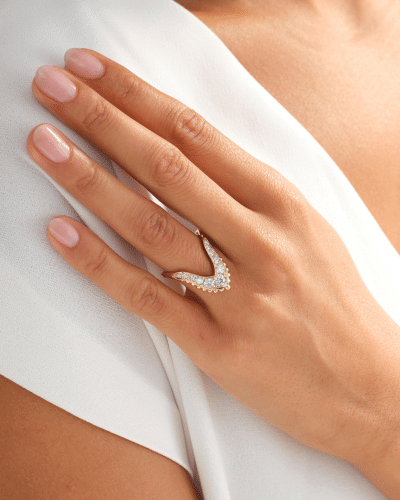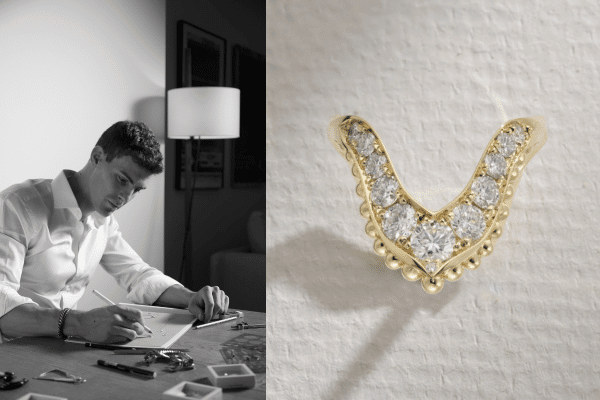What started as a passion for innovation has evolved into a cross-cultural journey for French-Australian jewellery designer Jean-Paul Baudet. He draws deep inspiration from India’s rich heritage—particularly the timeless Vanki ring, a symbol of protection and femininity.
Baudet honours the centuries-old culture behind this piece of heritage jewellery while infusing it with his unique, modern style.
But where did this journey begin and what is a Vanki ring?

Baudet’s journey with the Vanki ring began as a personal one. When designing an engagement ring for his then-fiancée, an Indian woman, she requested a design that reflected her cultural heritage. Drawing inspiration from the V-shaped armbands worn by her grandmother and the ring worn by a friend, she envisioned an engagement ring rooted in tradition. Baudet recalls, “We drafted up all the ideas and eventually landed on this two-stone design that had all the details I wanted to express but in the Vanki ring style. I realised how unique and under-celebrated this design was in New York, so I embraced that part of my wife into my jewellery line.”
The history of this design stretches back to ancient India, predating even the Vedic or Sangam periods. Traditionally, Vanki rings are passed down through generations in South India, symbolising protection and strength. They are thought to shield brides against evil and obstacles as they embark on new journeys, representing both beauty and resilience. Inspired by the protective symbolism rooted in ancient snake worship, these rings have evolved from symbols of ritual into cultural icons worn by brides as they step into married life.
Incorporating such traditional elements of Indian craftsmanship, Baudet’s work features intricate handwork, beadwork, filigree, and wire wrapping. “We aim to bring in a colourful flair,” Baudet explains. “We’ve integrated motifs like the paisley, drawing inspiration from Tamil temples with their vibrant stacks of colour. The paisley, or mango shape, symbolises prosperity, while other elements, like the parrot, signify human love.” This thoughtful infusion of traditional motifs, filigree, and ornate detailing embodies the hand-fabricated aesthetic distinct to Indian jewellery.

At the core of Baudet’s creative process is the theme of love. “Love is always the starting point—whether it’s someone’s love story or a nod to love in general,” he says. An unreleased design reflects the concept of water, symbolising love’s fluidity and depth. “With the Vanki ring, I think about honouring a love story within the shape, creating something comfortable and unmistakably Indian in inspiration. I don’t want it to look like Cartier or Van Cleef. This is an homage to Indian jewellery, but with a New York twist.”
For Baudet, paying tribute to Indian heritage is about more than aesthetics. He views his work as a modern continuation of an ancient cultural exchange. “It’s important to honour these traditions now as they were in the past. Roman nobility once wore Indian jewellery, and European elites had their stones cut and crafted in India,” he explains.

Baudet’s dedication to this lineage is evident in pieces like the Madras Vanki ring, which, while unmistakably Indian at first glance, carries a cosmopolitan sophistication that could easily be at home in Paris.
His unique background as an engineer has equipped Baudet with the technical skills necessary for this high level of craftsmanship. Having trained under artisans from Place Vendome, Baudet combines traditional methods with cutting-edge techniques from his New York studio. “I want to make couture jewellery of the highest quality,” he says. “Our craftsmanship is Parisian in its precision, New York in its complexity, and Indian in its inspiration.”
This fusion of tradition and innovation resonates with an increasingly diverse clientele. For Baudet, catering to the Indian diaspora in New York is both a challenge and an honour. “Indian women have a unique appreciation for jewellery; they celebrate it as part of their identity,” he notes. “I’m lucky to be married to a daughter of Indian migrants. The cultures I’ve been introduced to are invaluable, and I see an untapped market here for meaningful, culturally resonant jewellery.”

In a heartfelt admission, he adds, “I basically design jewellery that I think my wife would love. It’s about celebrating everything about her and her culture.”
In a city like New York, where contemporary and Euro-American designs often dominate, Baudet’s commitment to showcasing Indian design traditions offers a fresh perspective. He hopes to see his work become a bridge, connecting diverse audiences to India’s storied legacy in jewellery. “My goal is to see non-Indian women wearing Vanki rings as engagement rings, and for Indian-inspired jewellery to be as celebrated in high fashion as any European design. The diversity of New York is a perfect home for this vision, and it’s a privilege to share stories of love and culture through my work.”
With future projects on the horizon, from beaded Indian-inspired necklaces to pieces that integrate Australian and Indian motifs, Baudet continues his journey. His work is more than jewellery—it’s an artful celebration of the cultures, traditions, and love stories that inspire us all.
Read more: Sculpture by the Sea: Shining a light on Indian artists




